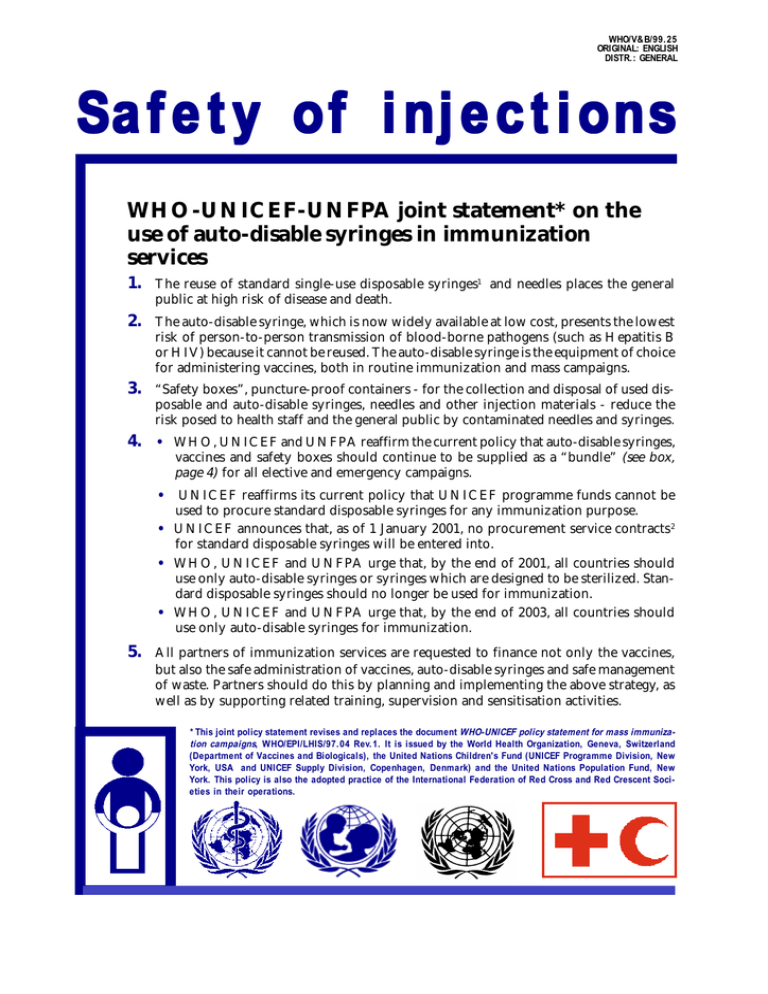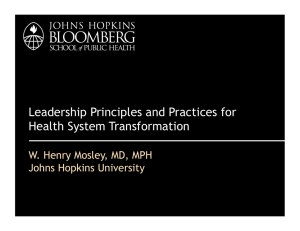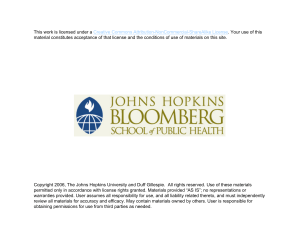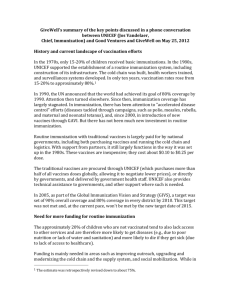Safety of injections WHO-UNICEF-UNFPA joint statement* on the services
advertisement

WHO/V&B/99.25 ORIGINAL: ENGLISH DISTR.: GENERAL Safety of injections WHO-UNICEF-UNFPA joint statement* on the use of auto-disable syringes in immunization services 1. The reuse of standard single-use disposable syringes1 and needles places the general public at high risk of disease and death. 2. The auto-disable syringe, which is now widely available at low cost, presents the lowest risk of person-to-person transmission of blood-borne pathogens (such as Hepatitis B or HIV) because it cannot be reused. The auto-disable syringe is the equipment of choice for administering vaccines, both in routine immunization and mass campaigns. 3. “Safety boxes”, puncture-proof containers - for the collection and disposal of used disposable and auto-disable syringes, needles and other injection materials - reduce the risk posed to health staff and the general public by contaminated needles and syringes. 4. • WHO, UNICEF and UNFPA reaffirm the current policy that auto-disable syringes, vaccines and safety boxes should continue to be supplied as a “bundle” (see box, page 4) for all elective and emergency campaigns. • UNICEF reaffirms its current policy that UNICEF programme funds cannot be used to procure standard disposable syringes for any immunization purpose. • UNICEF announces that, as of 1 January 2001, no procurement service contracts 2 for standard disposable syringes will be entered into. • WHO, UNICEF and UNFPA urge that, by the end of 2001, all countries should use only auto-disable syringes or syringes which are designed to be sterilized. Standard disposable syringes should no longer be used for immunization. • WHO, UNICEF and UNFPA urge that, by the end of 2003, all countries should use only auto-disable syringes for immunization. 5. All partners of immunization services are requested to finance not only the vaccines, but also the safe administration of vaccines, auto-disable syringes and safe management of waste. Partners should do this by planning and implementing the above strategy, as well as by supporting related training, supervision and sensitisation activities. *This joint policy statement revises and replaces the document WHO-UNICEF policy statement for mass immunization campaigns, WHO/EPI/LHIS/97.04 Rev.1. It is issued by the World Health Organization, Geneva, Switzerland (Department of Vaccines and Biologicals), the United Nations Children's Fund (UNICEF Programme Division, New York, USA and UNICEF Supply Division, Copenhagen, Denmark) and the United Nations Population Fund, New York. This policy is also the adopted practice of the International Federation of Red Cross and Red Crescent Societies in their operations. Background Information reaching WHO, UNICEF and UNFPA consistently highlights the widespread occurrence of unsterile injection practices and identifies a major cause as insufficient supplies of syringes and needles3. Unsafe injections can result in the transmission of blood-borne pathogens from patient-to-patient, patient-to-health worker and, more rarely, health worker-to-patient. The community at large is also at risk when injection equipment is used and then not safely disposed of. In many instances, used equipment is reused, sold or recycled because of its commercial value. The imperative to improve safety of injections in immunization services is underlined by the publication of articles in the WHO Bulletin (October 1999) which show that, although immunization injections are thought to be safer than curative injections, around 30% of immunization injections are still unsafe. Much evidence of reuse of disposable syringes exists and even recent country reviews suggest that sterilization of syringes and maintenance of sterilization equipment is not systematic. Last year, in the developing world, routine immunization of children under one year and immunization of women of childbearing age with tetanus toxoid (TT) accounted for over one billion injections. In addition to routine immunizations, measles control/ elimination activities and disease-outbreak control operations together delivered more than 200 million injections in the same year. Hepatitis vaccine is now in use in half of the developing countries and Hib, measlesmumps-rubella (MMR) and pentavalent vaccines are already widely used in the Americas. Acceleration of special activities which aim at the elimination of maternal and neonatal tetanus and at better control of measles has begun. And a Global Alliance of Partners of Immunization Services (GAVI) is being formed to assure access to new vaccines for many of the poorest countries where the vaccines are needed most. These increases of immunization services, including the elimination and control campaigns, offer an opportunity for improvement and make it imperative that injections are made safe for people. The disease burden associated with unsafe injection practices has been estimated4 and the cost implications of treatment of these diseases has been quantified 5. Each unsafe injection costs governments between three to five times the extra cost of auto-disable syringes (which guarantee a sterile injection), not to mention the toll in terms of human suffering. Strategy Over the past years, WHO, UNICEF and UNFPA have launched a number of initiatives which aim to improve the safety of injections. The most recent was the precursor to this joint statement in 19976 which related to the use of auto-disable syringes and safety boxes in immunization campaigns. That policy has assured the simultaneous budgeting and parallel purchasing and shipping of sufficient syringes and safety boxes for each consignment of vaccines for mass campaigns. Now, with a broad experience of the use of this equipment in the field, is the time to consolidate a policy to cover all administration of vaccine. 2 The use of auto-disable syringes in immunization ser vices services WHO and UNICEF have agreed to implement a strategy to ensure that special attention is paid to the safe administration of vaccines, both in routine immunization services and during mass campaigns. The policy statement (on page 1) defines the position of WHO and UNICEF and is intended as a guide to other partners of immunization services, including national ministries of health. In addition to this policy statement, WHO and UNICEF recommend that: • Countries exert maximum effort to ensure that procedures for injection safety are rigorous -this includes routine use and monitoring of indicators of sterilization while sterilizable equipment is still used. Partner agencies involved in immunization programmes in countries should provide maximum support for the strengthening of safe injection practices. • Urgent attention be given to develop appropriate tools (current monitoring tools are still insufficient to objectively demonstrate compliance to safe injection practices). • Agencies supporting immunization services be encouraged to provide time-limited financial support to countries procuring standard disposable syringes for immunization until government-won budgets can be increased to cover the additional cost of auto-disable syringes. • Agencies supporting immunization services which fund the purchase of locallymanufactured standard disposable syringes for immunization should assist countries with technology transfer to enable them to switch to auto-disable syringes in the shortest possible time. • Used auto-disable syringes should be deposited in safety boxes without re-capping, burned locally and the remains buried underground - until improved disposal methods are developed. Urgent attention should be given to develop improved means for effective, safe and environmentally-acceptable waste processing and final disposal of auto-disable syringes. ......................................... B. Melgaard Director, Vaccines & Biologicals World Health Organization ......................................... V. Li-Frankenstein Director, UNICEF Supply Division United Nations Children's Fund, Copenhagen ..................................... M. Nizamuddin Director, Technical and Policy Division United Nations Population Fund WHO/V&B/99.25 ......................................... S. Rasheed Director, UNICEF Programme Division United Nations Children's Fund, New York ..................................... Ibrahim Osman Under Secretary General, National Society, Cooperation and Development (NSCD), International Federation of Red Cross & Red Crescent Societies 3 FOOTNOTES 1 Auto-disable (A-D) syringes conform to the WHO/V&B Performance Specifications E8/DS1 and DS2 and include pre-filled pouch-and-needle injection devices. This statement applies only to available supplies of A-D syringes. 2 UNICEF procurement service contracts cover the procurement of supplies and equipment by UNICEF as a service to governments and other organizations. 3 Review: Unsafe injections in the developing world and transmission of blood-borne pathogens, Simonsen L (Ph.D.), Kane A, Lloyd J, Zaffran M, Kane M (M.D.), WHO Bulletin October 1999. 4 Unsafe injections in the developing world: Region based estimates of the transmission of bloodborne pathogens, Kane A et al. WHO Bulletin October 1999. 5 Direct and indirect costs of alternative injection technologies used in immunization services, Ekwueme et al. (Unpublished study with WHO, October 1999.) 6 Safety of Injections: WHO-UNICEF policy statement for mass immunization campaigns, WHO/ EPI/LHIS/7.04 Rev.1 – replaced by this statement, WHO/V&B/99.25. The term “bundling” has been chosen to define the concept of a theoretical “bundle” which must comprise each of the following items: • Good quality vaccines • Auto-disable syringes • Safety boxes The implication is that none of the component items can be considered alone; each component must be considered as part of a “bundle” which contains the other two. “Bundling” has no physical connotation and does not imply that items must be “packaged” together. Copies and information may be requested from: World Health Organization (WHO) Department of Vaccines and Biologicals, 20 Avenue Appia, CH-1211 Geneva 27, Switzerland Phone: +41 22 791 4373; Fax: +41 22 791 4193; E-mail: gpv@who.ch United Nations Children's Fund (UNICEF) 3 United Nations Plaza, New York, NY 10017, United States of America Phone: +1 212 824 6313; Fax: +1 212 824 6460; e-mail: ssakai@unicef.org United Nations Children's Fund (UNICEF) Supply Division, Freeport, 2100 Copenhagen ∅, Denmark Phone: +44 35 27 35 27; Fax: +44 35 26 94 21; E-mail: sdpublications@unicef.dk (UNFPA) United Nations Population Fund (UNFP A) Technical and Policy Division, 220 East 42nd Street - 17th floor, New York, NY 10017, United States of America Phone: +1 212 297 5211; Fax: +1 212 297 4915; E-mail: HQ@unfpa.org International Federation of Red Cross and Red Crescent Societies (IFRC) Case postale 372, CH-1211 Geneva 19, Switzerland Phone: +41 22 730 42 22; Fax: +41 22 733 0395; e-mail: secretariat@ifrc.org Ordering code: WHO/V&B/99.25. Printed: December 1999 ©W orld Health Organization 1999 World This document is not a formal publication of the W orld Health Organization (WHO), and all rights are reser ved by the OrganizaWorld reserved tion. The document may racted, repr oduced and translated, in part or in whole, but not for sale may,, however however,, be freely reviewed, abst abstracted, reproduced nor for use in conjunction with commercial purposes. The views expressed in documents by named authors are solely the responsibility of those authors. 4 The use of auto-disable syringes in immunization ser vices services


